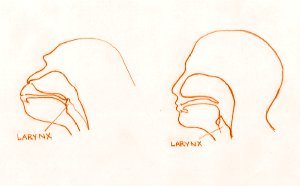|
Breath Holding and Pre-Adaptation for Speech
One important adaptation that must have occurred in order for humans to speak is the ability to
consciously hold one's breath. Other primates don't speak because they are physiologically
unable to voluntarily hold their breath. Also, the range of sounds that humans can make is a
result of our "descended" larynx. In humans the larynx is in a descended position. The only other
known animals with this feature are the dugong, sea lion and walrus (Morgan 1997). In the case
of humans, the larynx moves deeper into the throat, and no longer makes contact with the uvula, as
in other apes.
|

Gorilla; Human
|
|
The larynx begins its descent after birth, between 4 - 6 months of
age and by 18 months the larynx is in its final position at the base of the throat. This
morphological character
allows humans to take air in not only through the nose, but also through the mouth.
This attribute also allows for choking and the risk of death by drowning in one's
own fluids (Morgan 1997). What advantage would mouth breathing give us? Mouth breathing allows for
increased
intake of oxygen, allowing for greater endurance while running, for example. Mouth breathing also
allows for more air to be taken into the lungs before a dive, very quickly (Morgan 1997). Certainly, if we consider our
ancestors as purely savanna/dryland dwellers, then finding a good reason for this often
dangerous adaptation is very difficult.
|
